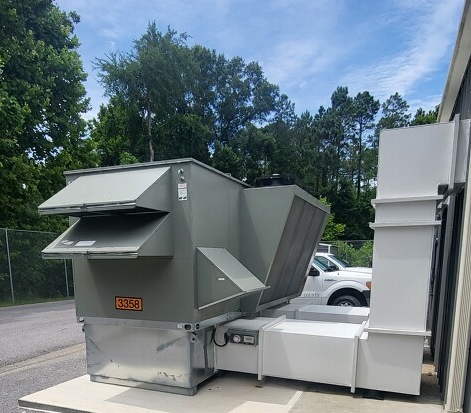Public works explains processes behind city paving
Published 11:22 am Friday, October 11, 2024

- Crews use a milling machine to grind up old asphalt before new pavement is put down along North Hills Street near King Road.
Meridian residents welcome the sight of fresh asphalt being laid on city streets, but few are aware of the processes behind paving projects and the reason some roads get paved while others do not.
Assistant Public Works Director Mike Van Zandt said the process starts with the pavement condition assessment, or paving index. The assessment, which the city had done approximately three years ago, involved taking scans of all of Meridian’s 330 miles of road, measuring cracks in the road and providing the city with data on which roads need the most attention and how much.
Trending
“They’re measuring the number, the size and the length of cracks in streets,” he said. “The more cracks there are, the more penetration by the elements there are below the surface, and that’s what’s causing it to decay. If you could seal the top of a road off and never allow rain to penetrate it, it would last indefinitely.”
The Plan
Ideally, Van Zandt said, a paving index would be used to inform road maintenance efforts, helping the city maintain the roads it has. The city does do some crack sealing, which creates the black lines residents see, and feel, on some roads, he said, but otherwise doesn’t do a lot of maintenance on streets.
Instead, Meridian uses the paving index to identify and fix the worst roads first. It’s a popular approach but not the most cost effective, he said. The index helps the city make comparisons between roads in a way that isn’t possible by observation alone.
“This helps us identify those streets because honestly, it is really hard to just get in a car and drive down the street and make real comparisons,” he said. “So we’ve got digital information that actually tells us a score, and we can use those scores to identify streets and groups of streets and make a more effective approach to resurfacing.”
Using the data from the index, Van Zandt said the city first works to classify roads as either roads it can handle with its in-house paving crew or roads that will need to be contracted out. While Meridian does do some paving of its own, the city can’t match the speed and manpower a professional paving contractor can bring to a project. Being able to work quickly and efficiently is important when paving main roads with lots of traffic, he said, and those projects are better left to contractors.
Trending
“So we want to restrict our crews to smaller streets with less traffic because they’re slower. They’re going to be there awhile, and if we would try to do the larger streets, we’re blocking traffic for a long period of time,” he said. “Not a good situation.”
Public Works Director David Hodge said another benefit of using a contractor for larger projects is redundancy of equipment. A broken paving machine will bring in-house paving to a halt, he said, but full-time paving companies will have multiple machines they can use in the event one breaks down.
One recent change in the paving process has been the city’s use of term bids for both paving and striping. The bids, which are good for 12 months, eliminate the need to advertise and bid individual paving projects and allow for crews to get to work as soon as funding is available.
In choosing which streets to pave, there is also an effort to build a network of newly paved roads for residents to drive on, Van Zandt said. Many of the main arteries have been paved along with streets that connect to them. While a resident may not see their street being paved, the goal is to have them be able to drive on freshly paved roads the majority of the time they’re traveling in Meridian, he said.
Mobilization is also taken into account when planning paving projects, Van Zandt said, as both in-house crews and contractors need time to move their equipment into place. When possible, he said, the city will try to pave multiple roads in the same area to minimize time spent transporting equipment.
“I would say, typically, we’re looking at at least two days mobilization to get all the equipment set up someplace where we can work,” he said of the city’s in-house paving crew.
Contractors also prefer to stay in one area when possible as moving is inefficient and costly. Projects involving long stretches of road or clusters of roads in one area are more attractive than hitting smaller roads all over town, he said.
The Project
Once a paving project gets underway, the first step is milling, Van Zandt said, which involves grinding up the top layer of asphalt to put new asphalt in its place. At one point, the city used to not bother with milling, putting fresh asphalt directly on top of the old road surface, he said, but doing that has its drawbacks.
Adding additional layers of asphalt raises the height of the road, which can cause problems with the stormwater runoff, access to underground utilities and more, he said. An additional problem with foregoing milling is the risk of delaminations, where the old and new layers of asphalt don’t stick together.
“In Meridian, you’ll often hear people say we’ve got a pothole, and we don’t,” he said. “We’ve got what’s called a delamination. They are really two different things.”
The difference is technical, however, as both potholes and delaminations feel similar to drivers, he said.
Milling solves both problems, Van Zandt said, maintaining the same height of the road and leaving a clean but rough surface from the milling machine that makes it easy for new asphalt to adhere strongly.
After milling is completed, paving crews can start putting down fresh asphalt. In some cases, Van Zandt said, some leveling work is needed to address dips in the road as well.
“Sometimes they have to do leveling courses where, even after milling, you’ve got some real dips and some uneven areas,” he said. “They’ll go into those areas and they’ll try to put in something to try to build up a little bit so you get a better ride overall.”
After that, Van Zandt said, it’s just a matter of putting the asphalt down and compacting it in place. Unlike concrete, he said, asphalt can be driven on immediately after its placed and does not need time to cure.
Striping, which are the white and yellow lines on the roadways, is the final step. Van Zandt said thermoplastic striping, the reflective material used on main roads, doesn’t stick well to fresh asphalt due to a surface residue on newly paved roads. The city usually waits a minimum of 10 days for that residue to wear off before coming back to add in the lines.
The Cost
Twenty-five years ago, it wasn’t uncommon for a new city administration to issue a $4 million bond and use the money to fund paving projects over the course of its four-year term, Van Zandt said. At the time, $4 million was enough to pave roughly 45 miles of road, he said.
“Now that same bond is going to get you about 10 to 12 miles,” he said.
As with many materials, the cost of asphalt has risen sharply following the coronavirus pandemic and isn’t expected to come back down. A petroleum based product, the cost is also heavily influenced by the price of oil.
According to data from the producer price index, a product of the U.S. Bureau of Labor Statistics tracking the cost of goods and services from the seller’s perspective, the cost of asphalt paving mixture has risen approximately 20% since January 2020 and more than tripled since 2000.
Currently, the city pays $111 for each ton of asphalt it buys from APAC, which is the only asphalt supplier in the area. While the amount of asphalt needed varies based on the thickness of the pavement layer and shape of the road, Van Zandt said one ton is enough to cover an area approximately 10 feet by 10 feet. Add up how many 10-foot squares are in a mile of roadway, and paving quickly becomes expensive, he said.
“We’re looking at $300,000 or a little better per mile,” he said. “So we’ve got 330 miles of streets. Do the math, and it’s a lot of money.”
Meridian’s main source of funding for paving comes from a 7% use tax on internet sales, which provides around $3 million per year. Roughly half of the money is already allocated for debt service on two $6 million paving bonds passed in 2020 and 2021, leaving approximately $1.5 million for paving projects.
Hodge said the city has also been fortunate to receive funding from the state Legislature to pave even more. North Hills Street, which was paved from Highway 19 to Highway 39 in 2023, was paid for with a $3.4 million state appropriation.
A recent project paving Front Street, Great River Drive, 22nd Avenue Heights and North Hills Street from Highway 39 to the city limits near Lamar School was also funded, in part, by state funding, Hodge said.
Despite the higher costs, Hodge said the city has been able to pave roughly 40-50 miles of road since he took over as director of public works in 2021. That is close to if not the most paving the city has ever done in a three-year span, he said.





